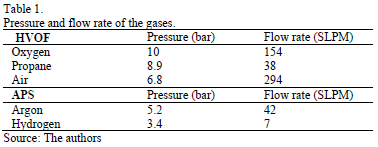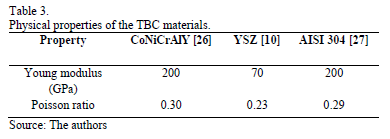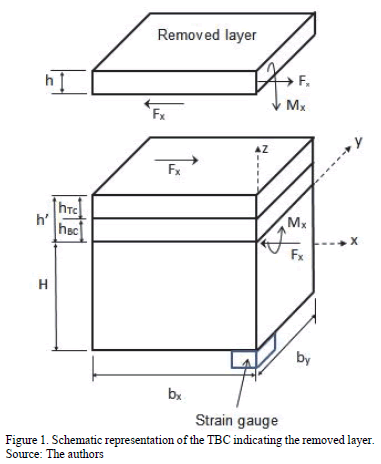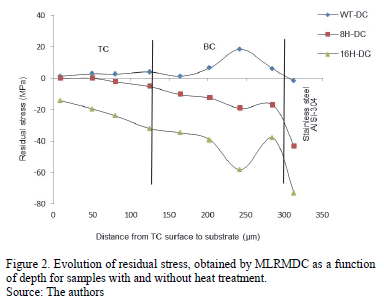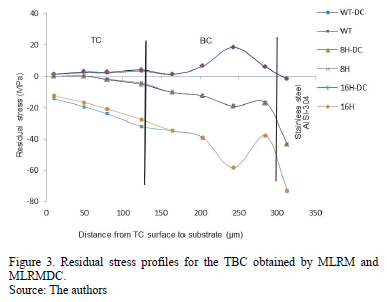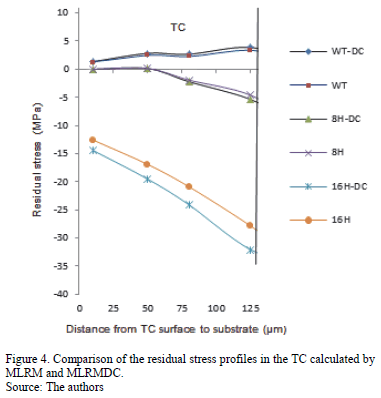Serviços Personalizados
Journal
Artigo
Indicadores
-
 Citado por SciELO
Citado por SciELO -
 Acessos
Acessos
Links relacionados
-
 Citado por Google
Citado por Google -
 Similares em
SciELO
Similares em
SciELO -
 Similares em Google
Similares em Google
Compartilhar
DYNA
versão impressa ISSN 0012-7353
Dyna rev.fac.nac.minas vol.83 no.197 Medellín maio/jun. 2016
https://doi.org/10.15446/dyna.v83n197.51150
DOI: http://dx.doi.org/10.15446/dyna.v83n197.51150
Study of the evolution of the residual stress state in thermal barrier coatings sprayed on AISI 304 stainless steel
Estudio de la evolución del perfil de esfuerzos residuales en recubrimientos barrera térmica depositados sobre acero inoxidable AISI 304
Pedro Yáñez-Contreras a, José Dolores Oscar Barceinas-Sánchez b, Carlos Agustín Poblano-Salas c, José Martín Medina-Flores d, Adrián Luis García-García b & Iván Domínguez-López b
a Universidad Politécnica de Guanajuato. Guanajuato, México. pyanez@upgto.edu.mx
b Centro de Investigación en Ciencia Aplicada y Tecnología Avanzada (CICATA-IPN). Querétaro, México. obarceinas@ipn.mx, agarciag@ipn.mx, idominguezl@ipn.mx
c Centro de Tecnología Avanzada (CIATEQ A.C). Querétaro, México. carlos.poblano@ciateq.mx
d Departamento de Ingeniería Mecánica, Instituto Tecnológico de Celaya (ITC), Guanajuato, México. martin.medina@itcelaya.edu.mx
Received: June 9th, 2015.Received in revised form: January 27th, 2016.Accepted: February 11th, 2016
This work is licensed under a Creative Commons Attribution-NonCommercial-NoDerivatives 4.0 International License.
Abstract
Thermal barrier coatings (TBC) were manufactured by thermal spraying of CoNiCrAlY and YSZ powders, which constituted the bond coat (BC) and top coat (TC), respectively. The BC was deposited on stainless steel substrates by a high velocity oxygen fuel (HVOF) system whilst the TC was deposited on the BC by an atmospheric plasma spraying (APS) gun .TBCs were heat treated at 1200 °C for 8 and 16 h in order to determine the evolution of the residual stress state as a function of time. The residual stress profiles were obtained by employing the Modified Layer Removal Method (MLRM) and an adaptation of this for bilayer coatings called Modified Layer Removal Method for Duplex Coatings (MLRMDC). It was observed that as the exposure time was increased, the compressive residual stresses increased, which was more noticeable in the BCs. The TBCs without heat treatment revealed tensile residual stresses.
Keywords: thermal barrier coating, residual stress, modified layer removal method, thermal spraying, Modified Layer Removal Method for Duplex Coatings.
Resumen
Se fabricaron recubrimientos barrera térmica depositando polvos de CoNiCrAlY y YSZ, los cuales constituyeron las capas de enlace y superior, respectivamente. La primera se depositó sobre el acero inoxidable AISI 304 mediante un sistema de oxígeno combustible de alta velocidad; mientras que la segunda se depositó mediante un sistema de rociado por plasma atmosférico. Los recubrimientos se trataron térmicamente a 1200 °C por 8 y 16 h con el fin de determinar la evolución del estado de esfuerzos residuales en función del tiempo. Los perfiles de esfuerzos residuales se determinaron empleando el método de remoción de capa modificada y una adaptación de éste para recubrimientos bicapa, llamado método de remoción de capa modificada para recubrimientos dúplex. Se encontró que conforme el tiempo de exposición se incrementó los esfuerzos residuales de compresión incrementaron, siendo más notorios en las capas de enlace. Los recubrimiento sin tratamiento térmico revelaron esfuerzos residuales de tensión.
Palabras clave: recubrimiento barrera térmica, esfuerzos residuales, método de remoción de capa modificada, rociado térmico, método de remoción de capa modificada para recubrimientos dúplex.
1. Introduction
Thermal barrier coatings (TBC) are commonly employed in hot sections of aeronautic and land turbines to provide protection against hot corrosion and oxidation of critical components [1,2]. A TBC is formed by two layers of different materials deposited on a metallic substrate. The external layer, also known as the top coat (TC), is commonly formed by ytria stabilized zirconia (YSZ), a ceramic with low thermal conductivity, good thermal-shock resistance and a relatively low thermal expansion coefficient [3-5]. On the other hand, the layer in contact with the substrate, known as the bond coat, is normally fabricated from a MCrAlY alloy (M = Co, Ni, or Co+Ni). Such a layer promotes good adherence of the TC to the substrate, as it has a thermal expansion coefficient similar to that of the substrate [7]. It also provides protection against oxidation [5,8] and hot corrosion [2,8] by forming a stable alumina thermally grown oxide (TGO) at the interface with the TC. TBCs can be processed entirely by thermal spraying; the BC is normally produced by employing the HVOF process, whereas the ceramic TC is fabricated by high temperature processes, such as atmospheric plasma spraying (APS). Both processes are cost-effective and produce good quality TBCs[9].
Residual stresses are always present in thermal spray coatings. They are produced by two known mechanisms: i) quenching of splats after impact the substrate and restricted contraction of them by adherence to the substrate; and ii) differential thermal expansion of the coating and the substrate during cooling. The stress state of a coating is important as it has a strong influence on its mechanical properties, which, in turn, affect its performance and durability [10, 11]. According to Widjaja et al. [12], the final stress state of a TBC is influenced not only by quenching of splats and thermal mismatch but also by phase transformation during coating deposition.
In the HVOF process the particles projected onto the substrate reach high velocities, and temperatures lower than those measured in the APS process, which in contrast produces a low velocity and high temperature plume, adequate for the deposition of ceramic powders. Despite those differences, it has been suggested that the coatings processed by each process to make a TBC, i.e. the BC and TC, respectively, have a compressive residual stress state [13], which opposes to the tensile stresses that are responsible for coating delamination during service [14].
Another important variable when processing a TBC by thermal spraying is substrate roughness. A substrate having high roughness promotes a compressive residual stress state in the BC, which improves the cracking resistance of the TBC [15]. Therefore, it is important to promote a compressive stress state in a TBC as a tensile stress state increases the coating susceptibility to delamination and cracking [16].
During the last decade, different techniques have been proposed to study the final stress state of TBCs that are produced by thermal spraying: x-ray diffraction [6, 16], indentation [17], finite element simulation [18, 20], material removal [21,22], hole drilling [23], 3D imaging correlation [24], and curvature evolution [17]. In this work, the residual stress state was evaluated by employing the Modified Layer Removal Method (MLRM) [25]. The method is based on the monitoring of strains in the coating after removing thin layers by fine grinding. This technique was developed for mono-layer systems; however, the method has also been employed in duplex systems but only considering the physical properties of one material in the calculations [21]. Here, the MLRM technique was modified in order to calculate the residual stress state of a TBC employing the physical properties of the BC and TC substrates. This modified procedure was named as the Modified Layer Removal Method for Duplex Coatings (MLRMDC). A comparison of the residual stress state of a TBC, with and without heat treatment at 1200 °C, obtained by employing the MLRM and MLRMDC methods, is presented in this work. 2. Materials and Methods
In this investigation, the MLRM and MLRMDC methods were used to calculate the residual stresses profiles of TBCs prior and after heat treatment at 1200 °C for 8 and 16 h. The following section describes each experimental stage.
2.1. Deposition of TBCs
Three TBCs were deposited on stainless steel AISI 304 substrates of 25.4 mm X 25.4 mm X 6.35 mm in size. The BC and TC were obtained by deposition of powders of a CoNiCrAlY alloy (AMDRY 9954, Co32Ni21Cr8Al0.5Y), and yttria stabilized zirconia (NS-204, YSZ), respectively: both from Sulzer Metco. Before deposition, the substrates were cleaned with acetone and grit blasted by an air stream carrying alumina particles that impacted at a 45° angle at a distance of 200 mm, they were then re-cleaned with acetone; the surface roughness (Ra) ranged from 3 to 7 µm. The BC was deposited by a HVOF system, model DJH2700 by Sulzer, with a powder feed rate of 38 g/min and a distance of 203 mm. The mean thickness of this layer was 180±5 µm. On the other hand, the TC was deposited by an APS system, model 9MB by Sulzer, with a powder feed rate of 45 g/min and a distance of 120 mm. The potential and current of the gun were set at 67 V and 600 A, respectively. The mean thickness of this layer was 120±3 µm. Each layer was built-up applying 16 passes at a gun lateral displacement speed of 1.5 m/s. Table 1 shows the pressures and flow rates of the gases employed.
2.2. Heat treatment of coatings
Once the TBCs were deposited, two samples were heat treated at 1200 °C using a closed muffle (by Nabertherm) in argon atmosphere, one for 8 h and the other for 16 h, Table 2. The heating rate was 6 °C/min. The sample without heat treatment (WT) was used for comparison.
2.3. Fixing and soldering of strain gauges
After heat treatment, the back faces of the samples were carefully ground and cleaned to eliminate oxide and dirt, thus ensuring an adequate attaching of the strain gauges. These devices were supplied by Vishay Precision Group Inc.
(model CEA-09-125UT-350). The gauges were joined to connecting wires by applying a tin-based solder. The connection verification and strain measurements were carried-out by means of a strain meter model P3500, also provided by the same supplier.
2.4. Residual stresses determination by MLRMDC
The method followed for the removal of thin layers of the TBC coating is described elsewhere [21,25]. The physical properties of all materials involved were considered when determining the residual stresses; stainless steel AISI 304 for substrate, CoNiCrAlY for BC, and YSZ for TC, Table 3.
The mathematical analysis of the stresses was performed using only a quarter of the sample, as shown in Fig. 1. The force and momentum acting on the removed layer along and around the X axis are Fx and Mx, respectively. Thickness of the removed layer, remaining layer, substrate, BC, and TC are h, h', H, hBC y hTC, respectively. The strain gauge was attached on samples' back face; bx and by are half of both length and width of the actual sample. Plane located at z = 0 is the interface substrate/BC.
Strain changes of the remaining part of the sample, after removing a thin layer by fine grinding, are given by:

Where  and
and  are sample curvatures.
are sample curvatures.
For a plain stress state, the stress-deformation equation is given by:

Where is a relationship that involves the Young modulus, and u the Poisson ratio of the materials.
is a relationship that involves the Young modulus, and u the Poisson ratio of the materials.
 is the Young modulus of the substrate,
is the Young modulus of the substrate,  of the BC, and
of the BC, and  of the TC:
of the TC:

Where  is the overall Young modulus of the TBC:
is the overall Young modulus of the TBC:

If  , then
, then  , but if
, but if  then
then  .
.
Where  is the sum of the thickness of removed layers.
is the sum of the thickness of removed layers.
The resulting forces and momenta along and around x and y axes are  and
and , and
, and  and
and , respectively, which are related with the stresses by means of eq. 5:
, respectively, which are related with the stresses by means of eq. 5:

Substituting equations (1) and (2) in (5) results:

Where:
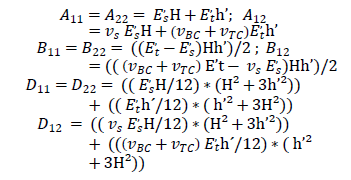
Using eq. (1) and the deformations measured by the strain gauges, equations for  and
and can be derived:
can be derived:

Substituting eq. (7) in (6) to eliminate  and
and ; thus eq. (8) is obtained:
; thus eq. (8) is obtained:

Where  and
and  are the stresses of the removed layer.
are the stresses of the removed layer.
Equations (6) and (8) are substituted in (7) in order to obtain 4 equations with 4 variables, 2 stresses and 2 curvatures. This is undertaken in terms of deformation changes and sample properties. Thus, the following is obtained:
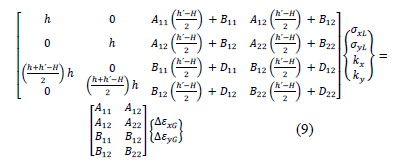
Equation (9) shows the equation system to be solved for the stresses of the removed layer,  and
and , and changes in the curvatures,
, and changes in the curvatures,  and
and . Equation (7) is used to calculate
. Equation (7) is used to calculate  and
and . Then, the residual stresses on the remaining part of the sample can be calculated by eq. (2).
. Then, the residual stresses on the remaining part of the sample can be calculated by eq. (2).
3. Results and Discussion
Different residual stresses are developed during the fabrication of TBCs by thermal spraying. A compressive stress state is first developed on the substrate front face when its surface is prepared by grit blasting. As the BC is deposited, a tensile residual stress is developed by particle quenching and restricted contraction on the substrate [5], and finally, when the TC is deposited, a mixed stress state is developed due to the significant difference in thermal expansion coefficients between both layers. Compressive residual stresses are developed in the TC, whereas the BC develops tensile residual stresses [28].
The residual stress profiles that were calculated by the procedure described in section 2.4 are presented in Figs. 2 and 3. Fig. 2 shows the residual stress profiles, obtained by MLRMDC, for the samples that were heat treated at 1200 °C for 8 and 16 h, and for that without heat treatment. The plots show how the residual stress varies from the TC surface to the substrate.
For the sample without heat treatment (WT-DC), an almost zero residual stress was measured on the TC surface, which agrees with what was reported by Lima et al. [21] and Weyant et al. [6]. This stress state resulted from the balance between the compressive and tensile stresses in the coating. The former stress is promoted by the large difference of thermal expansion coefficients of YSZ and CoNiCrAlY, whereas the latter is produced by rapid quenching of flying particles when impacting the substrate and previously deposited layers. At an approximate depth of 250 mm, within the BC, a residual tensile stress of 20 MPa was measured. Such behavior has also previously been reported by other authors [21, 29]. In this case, a dominant effect of quenching stress in the bond coat was evident. As the measurements approach the substrate, the stress state tended, once again, to be zero, and the residual stress measured within the substrate was compressive. Although the results obtained by the MLRMDC method in this work showed a similar behavior to those reported in the literature employing the MLRM procedure [21], the magnitude of the measured stresses was different for each technique. This behavior could be due to the different processing conditions employed in each case (substrate, fuel and spraying distance).
The residual stress profile of the TBC that was heat-treated at 1200 °C for 8 h (8H-DC, Fig. 2) also showed a near zero stress at the TC surface. From 50 mm only compressive stresses were measured. The highest residual stress (-19 MPa) in the coating was located within the BC, whereas a further increase, up to -40 MPa, was measured in the substrate. The residual stress profile of the TBC that was heat-treated at 1200 °C for 16h (16H-DC) revealed a stress of -18 MPa on the TC surface, which increased as the depth was increased. The profile of this sample showed the same trend as that of the sample treated for 8 h, but the magnitude of the stresses was higher; this behavior has also been reported by Khan et al. [3]. These authors reported an increase in compressive residual stresses of a TBC as the exposure time at high temperature was increased. The TBC that was heat-treated for 16 h also showed a maximum compressive residual stress (-58 MPa) within the BC at a depth of 250 mm. The substrate showed a larger compressive residual stress of -78 MPa. A BC having a large residual compressive stress promotes good adherence of the TBC to the substrate; therefore, an increased adherence is expected in heat-treated samples compared to that of the as sprayed counterpart. Also, a TBC having a compressive residual stress state shows higher resistance to cracking and delamination in service [15]. The operating temperature of aeronautic and land turbines are higher than the testing temperature employed in this work (1200 °C). This testing temperature was selected as in a future investigation the residual stress profiles of TBCs, affected by chemical attack of calcium magnesium alumino-silicate (CMAS), will be calculated by MLRMDC. CMAS attack normally occurs between 1100 and 1200 °C on TBCs in aeronautic turbines exposed to volcanic flying ashes or SiO-based sand.
Fig.3 shows the evolution of residual stress calculated by MLRM and MLRMDC as a function of depth. A similar behavior of the evolution of residual stress was observed for both methods for the substrate and BC. However, the stress magnitude for the TC was slightly different. Fig. 4 shows a magnified view of the residual stress profile calculated for the TC. The residual stresses on the surface of the samples without heat treatment and heat-treated for 8 h showed a difference smaller than 1 MPa, whereas for the sample heat-treated for 16 h the difference was about 2 MPa, which represents a dissimilarity of 15 % between both methods. The difference of the residual stress profiles, calculated by both methods for the TC, can be explained by the fact that the MLRMDC procedure takes into account the physical properties of the substrate, BC, and TC, whereas the MLRM only considers the physical properties of the substrate and TC.
This work should be regarded as an exploratory study aiming to provide an initial insight into the results obtained by MLRM and MLRMDC. This is why only one sample per condition was studied. A larger number of samples need to be studied in order to assess the error involved in each measurement and unambiguously determine if there is a statistically valid difference between both methods when calculating the residual stress profile through the TC. Nonetheless, it seems that the MLRM underestimates the magnitude of the stresses within the TC.
4. Conclusions
The evolution of residual stress state in the TBCs (YSZ/CoNiCrAlY), fabricated by thermal spraying, was obtained by employing the modified layer removal method for duplex coatings (MLRMDC). This method resulted in residual stress profiles similar to those obtained by MRLM, which is a procedure regularly reported in the literature to determine the residual stresses of coatings manufactured by thermal spraying. The results obtained employing both methods are in good agreement with those reported in the literature. The effect of heat treatment at 1200 °C on the evolution of the residual stress profiles was also studied here. It was also demonstrated that an increase in soaking time at high temperature eliminates all tensile stresses in the TBCs, which results in compressive stresses after heat treatment. This, in turn, may enhance the adherence and delamination resistance of the coating in service. Until this point, it seems that the MLRM may be underestimating the magnitude of the compressive stresses within the TC.
Acknowledgements
The main author gratefully acknowledges the scholarship granted by PROMEP that was used to carry out his Doctoral studies. Also, thanks to CICATA-IPN Querétaro, CIATEQ, NACOBRE and Universidad Politécnica de Guanajuato for providing the facilities to perform the experimental work. Finally, the authors acknowledge the financial support of the Secretaría de Investigación y Posgrado from the Instituto Politécnico Nacional, through Project Grant SIP 20121606.
References
[1] Loganathan, A. and Gandhi, A.S., Effect of phase transformations on the fracture toughness of t´ yttria stabilized zirconia. Materials Science & Engineering A 556 pp. 927-935, 2012. DOI: 10.1016/j.msea.2012.07.095 [ Links ]
[2] Osorio, J.D., Toro, A. and Hernández-Ortiz, J.P., Thermal barrier coatings for gas turbine applications: Failure mechanisms and key microstructural features. DYNA, [Online]. 79(176), pp. 149-158, 2012. Available at: http://www.revistas.unal.edu.co/index.php/dyna/article/view/28328/43558 [ Links ]
[3] Khan, A.N., Lu, J. and Liao, H., Effect of residual stresses on air plasma sprayed thermal barrier coatings. Surface and Coatings Technology 168, pp. 291-299, 2003. DOI: 10.1016/S0257-8972(03)00207-X. [ Links ]
[4] Osorio, J.D., Lopera-Valle, A., Toro A. and Hernández-Ortiz, J.P. Phase transformations in air plasma-sprayed yttria-stabilized zirconia thermal barrier coatings. DYNA, [Online]. 81(185), pp. 13-18, 2014. Available at: http://www.redalyc.org/articulo.oa?id=49631031002 [ Links ]
[5] Rajendran, R., Gas turbine coatings - An overview. Engineering Failure Analysis. 26, pp. 355-369, 2012. DOI: 10.1016/J.ENGFAILANAL.2012.07.007 [ Links ]
[6] Weyant, C.M., Almer, J. and Faber, K.T., Through-thickness determination of phase composition and residual stresses in thermal barrier coatings using high-energy X-rays. Acta Materialia 58, pp. 943-951, 2010, DOI: 10.1016/j.actamat.2009.10.010 [ Links ]
[7] Hyung-Jun, J., Dong-Ho, P., Yeon-Gil, J., Jung-Chel, J., Sung-Churl, C. and Ungyu. P., Mechanical characterization and thermal behavior of HVOF-sprayed bond coat in thermal barrier coatings (TBCs). Surface & Coatings Technology 200 pp. 4355-4436, 2006, DOI: 10.1016/j.surfcoat.2005.02.170 [ Links ]
[8] Zhao, L. and Lugscheider, E., High velocity oxy-fuel spraying of a NiCoCrAlY and an intermetallic NiAl-TaCr alloy. Surface and Coatings Technology 149, pp. 231-235, 2002. DOI: 10.1016/S0257-8972(01)01444-X [ Links ]
[9] Gómez-García, J., Poza, P. y Utrilla, V., Crecimiento y caracterización de recubrimientos cerámicos con aplicaciones como barreras térmicas. Bol. Soc. Esp. Cerámica y Vídrio 45(2), pp. 70-74, 2006. [ Links ]
[10] Teixeira, V., Andritschky, M., Fischer, W., Buchkremer, H.P. and Stöver, D., Effects of deposition temperature and thermal cycling on residual stress state in zirconia-based thermal barrier coatings. Surface and Coatings Technology (120-121) pp. 103-111, 1999. DOI: 10.1016/S0257-8972(99)00341-2 [ Links ]
[11] Hashmi, M.S.J., Pappalettere, C. and Ventola, F., Residual stresses in structures coated by a high velocity oxy-fuel technique. Journal of Materials Processing Technology, 75 pp. 81-86, 1998. DOI: 10.1016/S0924-0136(97)00295-1 [ Links ]
[12] Widjaja, S., Limarga A.M. and Yip, T.H., Modeling of residual stresses in a plasma-sprayed zirconia y alumina functionally graded-thermal barrier coating. Thin Solid Films 434 pp. 216-227, 2003. DOI: 10.1016/S0040-6090(03)00427-9 [ Links ]
[13] Bansal, P., Shipway, P.H. and Leen, S.B., Residual stresses in high-velocity oxy-fuel thermally sprayed coatings - Modelling the effect of particle velocity and temperature during the spraying process. Acta Materialia 55, pp. 5089-5101, 2007. DOI: 10.1016/j.actamat.2007.05.031 [ Links ]
[14] Lima, R.C. and Guilemany, J.M., Adhesion improvements of thermal barrier coatings with HVOF thermally sprayed bond coats. Surface & Coatings Technology, 201 pp. 4694-4701, 2007. DOI: 10.1016/j.surfcoat.2006.10.005 [ Links ]
[15] Zhang, X., Watanabe, M. and Kuroda, S., Effects of residual stress on the mechanical properties of plasma-sprayed thermal barrier coatings. Engineering Fracture Mechanics, 110 pp. 314-327, 2013. DOI: 10.1016/j.engfracmech.2013.08.016 [ Links ]
[16] Totemeier, T.C. and Wright, J.K., Residual stress determination in thermally sprayed coatings a comparison of curvature models and X-ray techniques. Surface & Coatings Technology, 200 pp. 3955-3962, 2006. DOI: 10.1016/j.surfcoat.2005.06.003 [ Links ]
[17] Chen, X., Yan, J. and Karlsson, A.M., On the determination of residual stress and mechanical properties by indentation. Materials Science and Engineering. A 416, pp. 139-149, 2006. DOI: 10.1016/j.msea.2005.10.034 [ Links ]
[18] Ng, H.W. and Gan, Z., A finite element analysis technique for predicting as-sprayed residual stresses generated by the plasma spray coating process. Finite Elements in Analysis and Design, 41, pp. 1235-1254, 2005. DOI: 10.1016/j.finel.2005.02.002 [ Links ]
[19] Wang, L., Wang, Y., Sun, X.G., He, J.Q., Pan, Z.Y. and Wang, C.H., Finite element simulation of residual stress of double-ceramic-layer La2Zr2O7/8YSZ thermal barrier coatings using birth and death element technique. Computational Materials Science, 53, pp. 117-127, 2012. DOI: 10.1016/j.commatsci.2011.09.028 [ Links ]
[20] Jiang Y., Xu, B.S., Wang, H.D. and Lu, Y.H., Finite element modeling of residual stress around holes in the thermal barrier coatings. Computational Materials Science, 49, pp. 603-608, 2010. DOI: 10.1016/j.commatsci.2010.05.057 [ Links ]
[21] Lima, C.R.C., Nin, J. and Guilemany, J.M., Evaluation of residual stresses of thermal barrier coatings with HVOF thermally sprayed bond coats using the Modified Layer Removal Method (MLRM). Surface & Coatings Technology, 200, pp. 5963-5972, 2006. DOI: 10.1016/J.SURFCOAT.2005.09.016 [ Links ]
[22] Jiang, L.M., Peng, J., Liao, Y.G., Zhou, Y.C., Liang, J., Hao, H.X. and Lu, C., A modified layer-removal method for residual stress measurement in electrodeposited nickel films. Thin Solid Films, 519, pp. 3249-3253, 2011. DOI: 10.1016/j.tsf.2011.01.260 [ Links ]
[23] Santana, Y.Y., La Barbera-Sosa, J.G., Staia, M.H., Lesage, J., Puchi-Cabrera, E.S., Chicot, D. and Bemporad, E., Measurement of residual stress in thermal spray coatings by the incremental hole drilling method. Surface & Coatings Technology, 201, pp. 2092-2098, 2006. DOI: 10.1016/j.surfcoat.2006.04.056 [ Links ]
[24] Zhu, J., Xie, H., Hu, Z., Chen, P. and Zhang, Q., Residual stress in thermal spray coatings measured by curvature based on 3D digital image correlation technique. Surface & Coatings Technology, 206 pp. 1396-1402, 2011, DOI: 10.1016/J.SURFCOAT.2011.08.062 [ Links ]
[25] Rybicki, E.F., Shadley, J.R., McGrann, R.T.R., Savarimuthu, A.C. and Graving, D., An ASM recommended practice for Modified Layer Removal Method (MLRM) to evaluate residual stress in thermal spray coatings. [Online]. 2000. Available at: www.asminternational.org/.../dvd?...an-asm-recomm [ Links ]
[26] Mao, W.G., Zhou, Y.C., Yang, L. and Yu, X.H., Modeling of residual stresses variation with thermal cycling in thermal barrier coatings. Mechanics of Materials, 38 pp. 1118-1127, 2006. DOI: 10.1016/j.mechmat.2006.01.002 [ Links ]
[27] Meza, J.M., Franco, E.E., Farias, M.C.M., Buiochi, F., Souza, R.M. y Cruz, J., Medición del módulo de elasticidad en materiales de ingeniería utilizando la técnica de indentación instrumentada y de ultrasonido. Revista de Metalurgia [Online], 44(1), pp. 52-65, 2008. Available at: http://revistademetalurgia.revistas.csic.es/index.php/revistademetalurgia/article/viewFile/95/94 [ Links ]
[28] Zhang, X.C., Xu, B.S., Wang, H.D. and Wu, Y.X., Optimum designs for multi-layered film structures base on the knowledge on residual stresses. Applied Surface Science, 253, pp. 5529-5535, 2007. DOI: 10.1016/J.APSUSC.2006.12.076 [ Links ]
[29] Kesler, O., Matejicek, J., Sampath, S., Suresh, S., Gnaeupel-Herold, T., Brand, P.C. and Prask, H.J., Measurement of residual stress in plasma-sprayed metallic, ceramic and composite coatings. USA. Materials Science and Engineering, A257. pp. 215-224,1998. DOI: 10.1016/S0921-5093(98)00860-0 [ Links ]
[30] Teixeira, V., Andritschky, M., Fischer, W., Buchkremer, H.P. and Stöver, D., Analysis of residual stresses in thermal barrier coatings. Journal of Materials Processing Technology, 92-93, pp. 209-216, 1999. DOI: 10.1016/S0924-0136(99)00157-0 [ Links ]
P. Yáñez-Contreras, received his BSc. Eng. in Mechanical Engineering in 1996 from the Instituto Tecnológico de Celaya, Mexico. He completed his MSc in the same Technological Institute in 2002. He is studying a PhD at the Instituto Politécnico Nacional in Querétaro, México. From 2000 to 2003 he worked for CIATEQ, A.C. designing machinery and equipment. He is currently a Full-Professor at the Universidad Politécnica de Guanajuato, México (UPGTO). His main research activities are mechanical properties of Thermal Barrier coatings. ORCID: 0000-0003-1124-6092
J.D.O. Barceinas-Sánchez, received his BSc. Eng. in Chemical Metallurgy in 1988 from the Universidad Autónoma de Querétaro, Mexico, his MSc in Metallurgy in 1992 from the Instituto Tecnológico de Saltillo, and his PhD degree in Materials Science in 1998 from the University of Sheffield, UK. From 1998 to 2008, he worked for CIATEQ, A.C. and since 2008 for the Instituto Politécnico Nacional as a Research Fellow in the Tribology Laboratory. His research interests include: friction and lubrication analysis, erosive wear of materials, and deposition and characterization of coatings. ORCID: 0000-0003-2059-5016
C.A. Poblano-Salas, is a BSc. in Metallurgical Engineering who graduated from the National University of Mexico (UNAM), Mexico. He completed his MSc in the same University in 1997. He received the "Alfonso Caso" medal in 1998, awarded for obtaining the highest score achieved for MSc studies in Metallurgy. He obtained a PhD degree in Materials Engineering from the University of Sheffield, UK, in 2005. He is member of the National Research System (SNI), level I, and has been since 2009. Currently, he works for CIATEQ A.C. in the Materials Department. His main research activities are focused on the production and characterization of functional coatings processed by different thermal spray techniques such as atmospheric plasma spray and HVOF. He also has broad experience in the processing of alloys by powder metallurgy and in the assessment of electrochemical properties of different materials. ORCID: 0000-0001-9375-6832
J.M. Medina-Flores, has a Ph.D. degree from the Department of Mechanical Engineering of the University of Guanajuato, México. He worked as performance engineer for three years for CIAT-GE at the Queretaro facility in México. He worked as Professor-Researcher at the Universidad Politécnica de Guanajuato, Mexico, for six years in the Design of Heat Transfer Equipment for Optimal use of Energy. His Research interests include the Robust Design of Thermo-Mechanics Systems for the efficient use of energy. Currently, he is involved in research with the thermal systems group at the Mechanical Engineering Department of the Instituto Tecnológico de Celaya, Guanajuato, México. ORCID: 0000-0001-7393-9033
A.L. García-García, is graduated from Ohio University, USA, with a PhD. in 1994. Currently, he is Full-Professor at the Instituto Politécnico Nacional, Centro de Investigación en Ciencia Aplicada y Tecnología Avanzada (CICATA), Mexico, institution which he led from April 2001 through November 2006. Prior to his current position, he has held full-time professor positions at the Autonomous University of Morelos State, Mexico and the Optical Communications Research Institute, Mexico. He has also had a full-time Research Associate position at the North Carolina State University, USA, at Raleigh, in conjunction with the University of California, at Berkeley, and carried out materials research at the Lawrence Berkeley National Laboratory, developing X-ray microscopes for the Advanced Light Source synchrotron. ORCID: 0000-0002-5121-9032
I. Domínguez-López, received his PhD in Physics in 1994 the Universidad Nacional Autónoma de México (UNAM), Mexico. From 1994 to 1998, he worked for the UNAM at the Institute of Physics; he worked from 1997 to 1999 as a Postdoctoral fellow; for two years at the Lawrence Berkeley National Laboratory, USA; and for one year at the University of Nevada, USA. From 2000 to 2003 he worked as a scientific coordinator at the Centro Nacional de Metrología in México at the Time and Frequency Department, and collaborated in the Atomic Fountain project at the physikalisch-technische bundesanstalt (PTB), in Germany. Currently, he is a Full Professor in the Materials Processing and Manufacturing group at the Centro de Investigación en Ciencia Aplicada y Tecnología Avanzada in Querétaro, México. His research interests include: Applied laser light to monitor wear processes and surface texturing to improve tribological behavior of knee prosthesis. ORCID: 0000-0001-8084-8711













